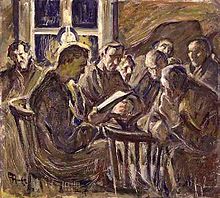Freedom of assembly



Freedom of assembly, sometimes used interchangeably with the freedom of association, is the individual right or ability of people to come together and collectively express, promote, pursue, and defend their ideas.[1] The right to freedom of association is recognized as a human right, a political right and a civil liberty.
The terms freedom of assembly and freedom of association may be used to distinguish between the freedom to assemble in public places and the freedom to join an association. Freedom of assembly is often used in the context of the right to protest, while freedom of association is used in the context of labor rights and in the Constitution of the United States is interpreted to mean both the freedom to assemble and the freedom to join an association.[2][failed verification]
The United States Constitution explicitly provides for 'the right of the people peaceably to assemble, and to petition the Government for a redress of grievances' in the First Amendment.
Common constraints on the right to assemble are a class of time, place and manner regulations. A second type of constraint is the requirement to obtain a permit, where coordination may be needed to ensure public safety.
Human rights instruments
The freedom of assembly is written about in the following human rights instruments:
- Universal Declaration of Human Rights - Article 20
- International Covenant on Civil and Political Rights - Article 21
- European Convention on Human Rights - Article 11
- American Convention on Human Rights - Article 15
Examples of the national and regional constitutions recognizing the freedom of assembly are:
- Bangladesh - Articles 37 and 38 of the Constitution of Bangladesh guarantee the freedom of association and assembly.[3]
- Brazil - Article 5
- Canada - S. 2 of the Canadian Charter of Rights and Freedoms which forms part of the Constitution Act, 1982
- France - article 431-1 of the Nouveau Code Pénal
- Germany - Art. 8 GG (Grundgesetz, Basic Law)
- Hong Kong Basic Law Section 27
- India - Fundamental Rights in India
- Italy - Article 17 of the Constitution[4]
- Japan - Article 21
- Macau Basic Law Article 27
- Constitution of the Philippines Article III, Section 4
- Republic of Ireland - Guaranteed by Article 40.6.1 of the Constitution of Ireland
- South Africa Bill of Rights Article 17
- Spain - Article 21 of the Spanish Constitution of 1978
- Turkey - article 33 and 34 of the Constitution of Turkey guarantee the freedom of association and assembly.
- Taiwan (Republic of China) - Article 14 guarantees freedom of assembly and association.
- United States - First Amendment to the Constitution of the United States
- Malaysia - Article 10 of the Constitution of Malaysia
- New Zealand - section 16 New Zealand Bill of Rights Act 1990
- Russia - Articles 30 and 31 of the Constitution of Russia guarantee the freedom of association and peaceful assembly.[5]
See also
- Freedom of assembly in Russia
- Strategy-31
- Free speech zone
- Unlawful assembly
- United Nations Special Rapporteur on the rights to freedom of peaceful assembly and of association
References
- ^ Jeremy McBride, Freedom of Association, in The Essentials of... Human Rights, Hodder Arnold, London, 2005, pg.18-20
- ^ Freedom Of Assembly
- ^ "Constitution of Bangladesh: Chapter III". Prime Minister's Office. Retrieved 2 October 2011.
- ^ "The Italian Constitution" (PDF). The official website of the Presidency of the Italian Republic.
- ^ "Constitution of Russia: Article 30". Adopted at National Voting on December 12, 1993.
External links
- Guidelines on Freedom of Peaceful Assembly OSCE/ODIHR, 2007
- Guidelines on Freedom of Peaceful Assembly (2nd edition) Venice Commission and OSCE/ODIHR, 2010
